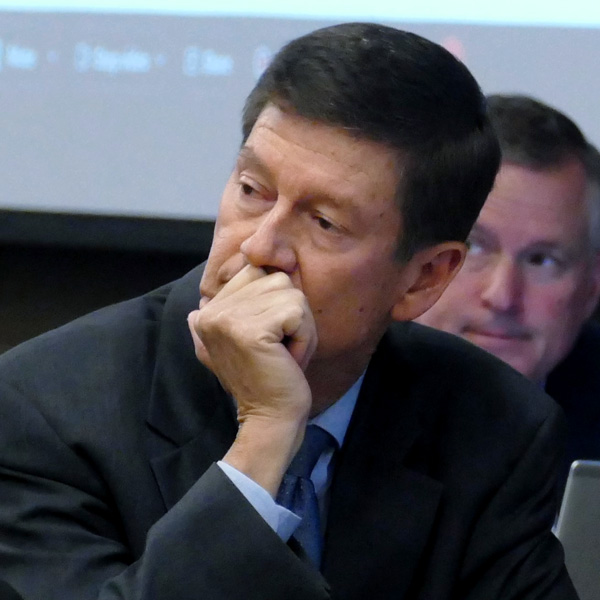The U.S. and Canada must increase interregional ties and cooperation to ensure reliability and affordability in the clean energy transition, government officials and industry executives from both sides of the border said at the New England-Canada Business Council’s 31st Annual Executive Energy Conference.
Speakers at the conference, which met in Boston on Thursday and Friday, highlighted the potential co-benefits of offshore wind and hydropower, arguing that increasing the bidirectional connections between New England and Eastern Canada would boost the reliability and affordability of the future grid.
Two days prior to the start of the conference, the U.S. Department of Energy announced it will become the anchor off-taker for the 1,200-MW Twin States Clean Energy Link project, which will connect Vermont and New Hampshire to Québec. (See DOE to Sign up as Off-taker for 3 Transmission Projects.) The line will allow for the bidirectional flow of electricity, enabling New England to import hydropower from Québec and export excess offshore wind energy depending on regional needs.
Maria Robinson, director of DOE’s Grid Deployment Office, said at the conference the project will “enhance the capacity of the grid here in New England as well as provide additional resilience, reliability and efficiency between our two countries.”
“The line will certainly deliver clean energy from Canada through hydropower to New England, and potentially at some point soon to Canada through solar and offshore wind here in the United States,” Robinson added.
Serge Abergel of Hydro-Québec touted the potential benefits of using hydropower to balance out wind power and reduce curtailment instead of simply using hydropower as baseload.
Hydropower “can essentially follow the patterns of wind,” Abergel said. “There is the potential for us to optimize and not send 24/7 but send energy when needed and get back excess power when there’s too much [in New England].”
Hydro-Québec on Thursday announced its plans to spend about $100 billion to increase its production and grid capacity. The company is hoping to add up to 4,200 MW of hydropower production capacity, from both new dams and renovations to existing facilities.
A Difficult Transition
Throughout the conference, speakers emphasized the vast amount of infrastructure that will be needed to meet the energy transition, as well as significant costs and regulatory challenges.
“On the broader permitting side, very few people, I fear, appreciate the scope of what net zero looks like,” said Christopher Guith, senior vice president of the U.S. Chamber of Commerce’s Global Energy Institute, citing the need for new transmission lines and pipelines to move carbon dioxide or hydrogen.
Guith said there’s bipartisan acknowledgement the permitting process needs major changes, and Democrats and Republicans in the Senate ultimately will need to “sit down like big boys and big girls and figure out how to get the 60 votes.”
“It is so much easier to make targets than actually achieve them,” said Monica Gattinger, professor of political studies at the University of Ottawa. “There is a growing recognition of ‘holy crap, this is a lot more complicated than we realized.’”
Gattinger added that navigating the sometimes competing needs for decarbonization and affordability is proving to be a challenge for policymakers across Canada.
“We do a lot of tracking of public opinion at the University of Ottawa, and when people have their hats on as citizens, they are all for climate action,” Gattinger said. “But if they put on their hats as consumers … affordability and issues around siting start to become much more important.”
Multiple speakers emphasized the importance of community engagement to ensure tangible local benefits, and education to connect new infrastructure needs and rising electric bills to climate change and emissions reductions, as a way to help bridge this gap.
“It isn’t engineering that’s our issue in Canada, and I don’t think it is in the United States either” said Jacob Irving, CEO of the Energy Council of Canada. “The No. 1 most difficult thing is public acceptance of these projects.”
Irving, along with most of the Canadian panelists and presenters, spoke about the importance of strong relationships with indigenous communities. Several of the speakers acknowledged the historical disregard that energy developers have often had for indigenous communities, although no indigenous groups from either country were represented among the conference’s speakers.
“If you do not have sufficient partnership with indigenous communities, you do not have a project in Canada,” Irving said.
More Gas?
Asked whether New England needs to increase its gas import capacity to meet growing demand on the grid, Stephen Woerner, president of National Grid New England, and Joseph Purington, CEO of Central Maine Power, said gas may be needed until clean energy can displace it.
“Any shortage of fuel to make electricity jeopardizes reliability, and if we’re going to become more dependent on the [electric] system, we have to make sure that that doesn’t happen,” Woerner said. “Cost-effective long-term storage can help, but it doesn’t eliminate the need for fuel.”
“We need the bridge to get from where we are today to where we’re going to be,” said Purington. “I think that’s going to have to be part of that solution as it is right now. Especially if we’re continuing to stumble out of the gate.”
Enbridge announced earlier this fall it’s pursuing a project to expand pipeline capacity into New England to address projected demand increases from both the gas network and the grid. The project has been heavily criticized by local climate and environmental groups. (See Enbridge Announces Project to Increase Northeast Pipeline Capacity.)
Meanwhile, Jamie Van Nostrand, chair of the Massachusetts Department of Public Utilities, expressed concern in September about the state’s gas utilities continuing to add connections to the distribution network, saying it seems to be “business as usual in the natural gas industry with respect to new residential hookups and continuing levels of load growth.”



